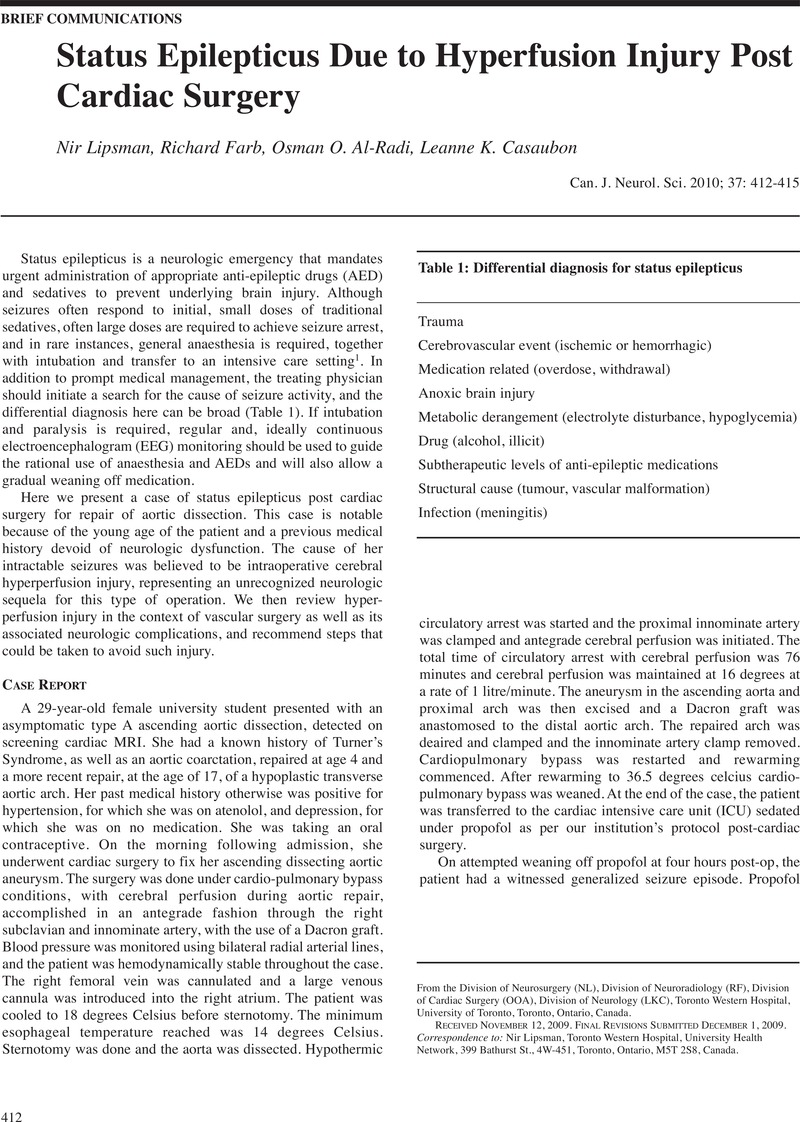No CrossRef data available.
Article contents
Status Epilepticus Due to Hyperfusion Injury Post Cardiac Surgery
Published online by Cambridge University Press: 02 December 2014
Abstract
An abstract is not available for this content so a preview has been provided. As you have access to this content, a full PDF is available via the ‘Save PDF’ action button.

- Type
- Brief Communications
- Information
- Copyright
- Copyright © The Canadian Journal of Neurological 2010
References
1.
Chen, JW, Wasterlain, CG.
Status epilepticus: pathophysiology and management in adults. Lancet Neurol.
2006 Mar;5(3):246–56.CrossRefGoogle ScholarPubMed
2.
Torgovnick, J, Sethi, N, Arsura, E.
Cerebral hyperperfusion syndrome occurring three weeks after carotid endarterectomy. Rev Bras Cir Cardiovasc.
2007 Mar;22(1):116–8.CrossRefGoogle ScholarPubMed
3.
Adhiyaman, V, Alexander, S.
Cerebral hyperperfusion syndrome following carotid endarterectomy. QJM.
2007 Apr;100(4):239–44.CrossRefGoogle ScholarPubMed
4.
Jun, HJ, Lee, Y, Hwang, YH, Cho, KH.
MRI image on hyperperfusion syndrome following aorto-bicarotid and aorto-biaxillary bypass for Takayasu’s arteritis. Eur J Cardiothorac Surg.
2005 Nov; 28(5):771.CrossRefGoogle ScholarPubMed
5.
Wijdicks, EF, Campeau, N, Sundt, T.
Reversible unilateral brain edema presenting with major neurologic deficit after valve repair. Ann Thorac Surg.
2008 Aug;86(2):634–7.CrossRefGoogle ScholarPubMed
6.
Rippy, EE, Wolfe, JH.
Cerebral hyperperfusion syndrome-a case report and literature review. Vasc Endovascular Surg.
2002 Jul-Aug;36(4):291–5.CrossRefGoogle ScholarPubMed
7.
van Mook, WN, Rennenberg, RJ, Schurink, GW, van Oostenbrugge, RJ, Mess, WH, Hofman, PA, et al.
Cerebral hyperperfusion syndrome. Lancet Neurol.
2005 Dec;4(12):877–88.CrossRefGoogle ScholarPubMed
8.
Ogasawara, K, Komoribayashi, N, Kobayashi, M, Fukuda, T, Inoue, T, Yamadate, K, et al.
Neural damage caused by cerebral hyperperfusion after arterial bypass surgery in a patient with moyamoya disease: case report. Neurosurgery.
2005 Jun;56(6): 1380–6.CrossRefGoogle Scholar
9.
Keunen, R, Nijmeijer, HW, Tavy, D, Stam, K, Edelenbosch, R, Muskens, E, et al.
An observational study of pre-operative transcranial Doppler examinations to predict cerebral hyperperfusion following carotid endarterectomies. Neurol Res.
2001 Sep;23(6):593–8.CrossRefGoogle ScholarPubMed
10.
Floyd, TF, Shah, PN, Price, CC, Harris, F, Ratcliffe, SJ, Acker, MA, et al.
Clinically silent cerebral ischemic events after cardiac surgery: their incidence, regional vascular occurrence, and procedural dependence. Ann Thorac Surg.
2006 Jun;81(6): 2160–6.CrossRefGoogle ScholarPubMed
11.
Coutts, SB, Hill, MD, Hu, WY.
Hyperperfusion syndrome: toward a stricter definition. Neurosurgery.
2003 Nov;53(5):1053–8.Google Scholar
12.
Di Bonaventura, C, Bonini, F, Fattouch, J, Mari, F, Petrucci, S, Carnì, M, et al.
Diffusion-weighted magnetic resonance imaging in patients with partial status epilepticus. Epilepsia.
2009 Jan;50; Suppl 1:45–52.CrossRefGoogle ScholarPubMed
13.
Yu, JT, Tan, L.
Diffusion-weighted magnetic resonance imaging demonstrates parenchymal pathophysiological changes in epilepsy. Brain Res Rev.
2008 Nov;59(1):34–41.CrossRefGoogle ScholarPubMed
14.
Chu, K, Kang, DW, Kim, JY, Chang, KH, Lee, SK.
Diffusion-weighted magnetic resonance imaging in nonconvulsive status epilepticus. Arch Neurol.
2001 Jun;58(6):993–8.CrossRefGoogle ScholarPubMed
15.
Bronen, RA.
The status of status: seizures are bad for your brain’s health. AJNR Am J Neuroradiol.
2000 Nov-Dec;21(10):1782–3.Google ScholarPubMed
16.
Lansberg, MG, O’Brien, MW, Norbash, AM, Moseley, ME, Morrell, M, Albers, GW.
MRI abnormalities associated with partial status epilepticus. Neurology.
1999 Mar 23;52(5):1021–7.CrossRefGoogle ScholarPubMed
17.
Szabo, K, Poepel, A, Pohlmann-Eden, B, Hirsch, J, Back, T, Sedlaczek, O, et al.
Diffusion-weighted and perfusion MRI demonstrates parenchymal changes in complex partial status epilepticus. Brain.
2005 Jun;128(Pt 6):1369–76.CrossRefGoogle ScholarPubMed
18.
Bartynski, WS.
Posterior reversible encephalopathy syndrome, part 1: fundamental imaging and clinical features. AJNR Am J Neuroradiol.
2008 Jun;29(6):1036–42.CrossRefGoogle ScholarPubMed
19.
Osborn, AG.
The circle of Willis. In: Osborn, AG, editor. Diagnostic cerebral sngiography. New York: Lippincot Williams and Wilkins; 1999. p. 105–16.Google Scholar


